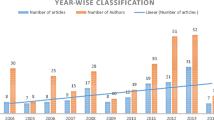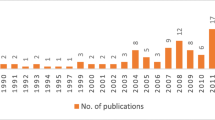Abstract
The researcher set out to investigate whether people form dependencies with toponyms (place names) in similar ways to which dependencies can be formed with places. It has been found that while people are dependent on a place to provide particular facilities, people and governments are also dependent on toponyms to provide particular branding requirements. The theory of toponymic dependence has been developed and this article outlines how toponymic dependence is determined by the ability of a toponym to provide a unique representation, or branding opportunity, of a place. This article provides the framework for future publications, which assess the adequacy of past government place branding proposals, and discusses the importance of considering the construct of place dependence when developing place branding campaigns.


Similar content being viewed by others
Notes
Victoria is a State of the country Australia.
Owing to the fact that the National Park crosses sections of four local government area boundaries, it is difficult to ascertain the exact population size of the study area. The figures provided are based on data available from the Australian Bureau of Statistics for the Northern and Southern Grampians Statistical Local Areas, which cover the majority of the National Park area.
In Australian politics the Labor Party is considered to be predominantly left-wing.
References
Anholt, S. (2004) Editorial. Place Branding and Public Diplomacy 1: 4–11.
Anholt, S. (2008) Place branding: Is it marketing, or isn’t it? Place Branding and Public Diplomacy 4: 1–6.
Australian Bureau of Statistics. (2006) 2006 Census QuickStats: S.Grampians and N.Grampians (Statistical Local Area). Canberra: Australian Bureau of Statistics.
Azarya, V. (2004) Globalization and international tourism in developing countries: Marginality as a commercial commodity. Current Sociology 52: 949–967.
Blain, C., Levy, S. and Ritchie, B. (2005) Destination branding: Insights and practices from destination management organisations. Journal of Travel Research 43: 328–338.
Clark, I. and Harradine, L. (1990) The restoration of Jardwadjali and Djab Wurrung names for rock art sites and landscape features in and around the Grampians National Park. A Submission to the Victorian Place Names Committee, Melbourne: Koorie Tourism Unit.
Cuba, L. and Hummon, D. (1993) A place to call home: Identification with dwelling, community and region. Sociological Quarterly 34: 111–131.
Dewsbury, J.D. (2003) Witnessing space: ‘Knowledge without contemplation'. Environment and Planning A 35: 1907–1932.
Dillman, D. (1978) Mail and Telephone Surveys: The Total Design Method. New York: John Wiley Sons.
Fan, Y. (2006) Branding the nation: What is being branded. Journal of Vacation Marketing 12: 5–14.
Feld, S. and Basso, K. (1996) Senses of Place. Santa Fe: School of American Research.
Fraser, J. (2005) The Roman Conquest of Scotland: The Battle of Mons Graupius AD84. Gloucestershire: Tempus.
Grant, L. (1990) Don’t handicap tourism with name changes. The Sun 5 June, Melbourne.
Hanna, S. and Rowley, J. (2008) An analysis of terminology use in place branding. Place Branding and Public Diplomacy 4: 61–75.
Hay, R. (1998) A rooted sense of place in cross-cultural perspective. Canadian Geographer 42: 245–266.
Herningway, W. (2007) Placemaking-cultural branding. Place Branding and Public Diplomacy 3: 332–336.
Hidalgo, C. and Hernandez, B. (2001) Place attachment: Conceptual and empirical questions. Journal of Environmental Psychology 21: 273–281.
Holmes, J. (1990) VFF must oppose changes. Ararat advertiser, ararat 2 June.
Jorgensen, B. and Stedman, R. (2006) A comparative analysis of predictors of sense of place dimensions: Attachment to, dependence on, and identification with lakeshore properties. Journal of Environmental Management 79: 316–327.
Kostanski, L. (2005) Spurious etymologies: Toponymic books and town name identities of the Murray river. Victorian Historical Journal 76: 211–224.
Kostanski, L. (2009) ‘What's in a name?' Place and toponymic attachment, identity and dependence. A case study of the Grampians (Gariwerd) national park name restoration process. PhD thesis, University of Ballarat, Ballarat (Australia), http://trove.nla.gov.au/work/36380333.
Kotler, P. and Gertner, D. (2002) Country as brand, product and beyond: A place marketing and brand management perspective. In: N. Morgan, A. Pritchard and R. Pride (eds.) Destination Branding: Creating the Unique Destination Proposition. Oxford: Elsevier Butterworth-Heinemann, pp. 40–56.
Manzo, L. (2003) Beyond house and haven: Toward a revisioning of emotional relationships with places. Journal of Environmental Psychology 23: 47–61.
Mccabe, S. and Stokoe, E. (2004) Place and identity in tourists’ accounts. Annals of Tourism Research 31: 601–622.
Moilanen, T. and Rainisto, S. (2009) How to Brand Nations, Cities and Destinations. Houndmills: Palgrave Macmillan.
Morgan, N. and Pritchard, A. (2002) Meeting the destination branding challenge. In: N. Morgan, A. Pritchard and R. Pride (eds.) Destination Branding: Creating the Unique Destination Proposition. Oxford: Elsevier Butterworth-Heinemann, pp. 59–78.
Papadopoulos, N. (2004) Place branding: Evolution, meaning and implications. Place Branding and Public Diplomacy 1: 36–49.
Patterson, M. and Williams, D. (2005) Maintaining research traditions on place: Diversity of thought and scientific progress. Journal of Environmental Psychology 25: 361–380.
Pretty, G., Chipuer, H. and Bramston, P. (2003) Sense of place amongst adolescents and adults in two rural Australian towns: The discriminating features of place attachment, sense of community and place dependence in relation to place identity. Journal of Environmental Psychology 23: 273–287.
Robinson, D. (1989) The language and significance of place in Latin America. In: J.A. Agnew and J. Duncan (eds.) The Power of Place: Bringing Together Geographical and Sociological Imaginations. Boston: Unwin Hyman, pp. 157–184.
Ryan, C. and Huyton, J. (2000) Aboriginal tourism – A linear structural relations analysis of domestic and international tourist demand. International Journal of Tourism Research 2: 15–29.
Shamai, S. (1991) Sense of place: An empirical measurement. Geoforum 22: 347–358.
Sharpe, E. and Ewert, A. (2000) Interferences in place attachment: Implications for wilderness, www.wilderness.net/library/documents/Sharpe_3-29.pdf.
Shumaker, S. and Taylor, R. (1983) Toward a clarification of people-place relationships: A model of attachment to place. In: N. Feimer and E. Geller (eds.) Environmental Psychology: Directions and Perspectives. New York: Praeger Publishers, pp. 219–251.
Skinner, H. and Kubacki, K. (2007) Unravelling the complex relationship between nationhood, national and cultural identity and place branding. Place Branding and Public Diplomacy 3: 305–316.
Smith, J. (1996) Ramifications of region and senses of place. In: E. Carville, K. Mathewson and M. Kenzer (eds.) Concepts in Human Geography. Lanham: Rowman & Littlefield, pp. 189–211.
Stokols, D. and Shumaker, S. (1981) People in places: A transactional view of settings. In: J. Harvey (ed.) Cognition, Social Behaviour and the Environment. New Jersey: Erlbaum, pp. 441–488.
Tourism Victoria. (2008) Grampians Market Profile Year Ending December 2007. Melbourne: Tourism Victoria.
Victorian Tourism Commission. (1990) Tourism and the Grampians Region: A Background Paper. Melbourne: Victorian Tourism Commission.
White, D., Virden, R. and Van Riper, C. (2008) Effects of place identity, place dependence, and experience-use history on perceptions of recreation impacts in a natural setting. Environmental Management 42: 647–657.
Williams, D. (2000) Notes on measuring recreational place attachment, http://www.fs.fed.us/rm/value/docs/pattach_notes.pdf.
Williams, D., Anderson, B.S., Mcdonald, C. and Patterson, M. (1995) Measuring place attachment: More preliminary results. NRPA Leisure Research Symposium, University of Illinois, San Antonio, Texas.
Williams, D., Patterson, M., Roggenbuck, J. and Watson, A. (1992) Beyond the commodity metaphor: Examining emotional and symbolic attachment to place. Leisure Science 14: 29–46.
Williams, D. and Vaske, J. (2003) The measurement of place attachment: Validity and generalizability of a psychometric approach. Forest Science 49: 830–840.
Wimmera Mail-Times. (1989) Gramps Rename Blasted. Horsham: The Wimmera Mail-Times, 29 March 1989. p. 1.
Acknowledgements
This research was supported by Linkage Grant LP0454321 provided by the Australian Research Council, the Victorian Office of the Surveyor-General and the University of Ballarat.
Author information
Authors and Affiliations
Corresponding author
Rights and permissions
About this article
Cite this article
Kostanski, L. Toponymic dependence research and its possible contribution to the field of place branding. Place Brand Public Dipl 7, 9–22 (2011). https://doi.org/10.1057/pb.2010.35
Received:
Revised:
Published:
Issue Date:
DOI: https://doi.org/10.1057/pb.2010.35




